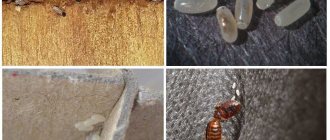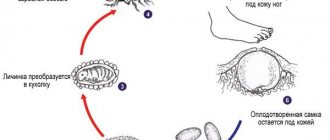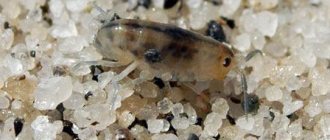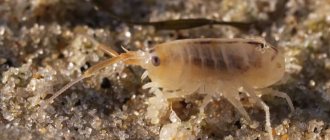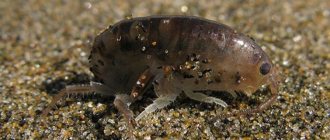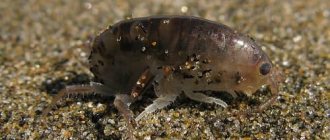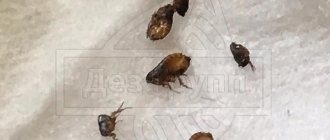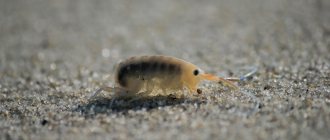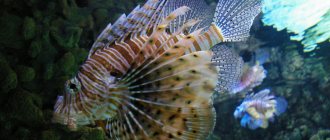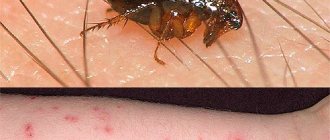Alexandr
Updated: November 6, 2019
Reading time: 12 minutes
Font A A
Many people like to go on vacation to southern countries, but not everyone knows that a rather serious danger awaits them there. Hot sun and warm sand can end up in big trouble for those who don't follow safety rules. Along with insects that simply bite, there are also those that can easily reproduce right under human skin.
Who are sand fleas and where do they live?
Sand fleas are small parasites that live on beaches in countries such as Southeast Asia, Africa, and South America. In Thailand there are practically none, but in India and Vietnam there are quite a lot. These parasites are most widespread in the Caribbean.
The length of the insects does not exceed two millimeters, so it is almost impossible to notice them in the sand. These fleas are excellent jumpers; the distance of one jump can reach 35 cm. Long hind legs contribute to this distance.
The appearance, like that of all other fleas, is very repulsive. The dark brown body is equipped with special bristles that allow these insects to cling to animal fur, skin and clothing. The shell is very durable, covered with a chitinous layer - sand parasites are almost impossible to crush with your fingers.
The larvae of these insects resemble white worms 3-4 mm long. The female lays them in the garbage, on the floors of living quarters, in the grass and any other shady places where there is organic matter - the larvae feed on it after hatching from the eggs. Adult insects live mainly on wild beaches. Hotels and inns that constantly receive crowds of tourists are well aware of the problem with fleas, which is why they regularly clean beaches and areas. For this reason, you should choose only well-groomed places for relaxation and walks.
Description of the insect
The sand flea is commonly known as the amphipod, or beach flea, and prefers exceptionally warm climates. That is why the sand flea has chosen Africa, Central and South America, the Caribbean, as well as the coast of India near the beaches of the Andaman Islands. Currently, the penetration of these fleas into Asia is increasingly being recorded.
Larva
The larvae of this small parasite resemble tiny legless white worms. They have no eyes, and their mouthparts have chewing functions. Their body length is only 4 millimeters. The main habitat of the larvae is sandy soil. This is what determines the species name. The larvae molt three times. They then pupate, and the final stage is complete metamorphosis. After just three weeks, the larvae transform into small but very active adults.
Adults
The flea's body is slightly flattened on the sides and is equipped with a compacted chitinous cover. A pair of eyes is located on a rounded head. The third pair of limbs is designed for jumping. The flea body contains large amounts of natural rubber.
The oral apparatus allows the adult to quickly pierce the skin and, using powerful swallowing pumps, draw blood from the capillaries. The blood then enters the narrow esophagus through the pharynx and then moves to the dilated proventriculus. Its posterior part protrudes directly into the midgut to form the cardiac valve. Peristalsis allows the blood in the stomach and proventriculus to mix freely. A significant part of the abdomen is occupied by the midgut, which performs not only secretory, but also absorption functions.
How they bite
Unlike simple fleas, sand fleas can not only drink blood, but also crawl under the skin, which ultimately leads to serious consequences.
Males and females bite differently. If the former cling to the skin for some time and fall off after saturation, then the latter, in addition to feeding, also multiply under the skin of a person or animal. The female sand flea bites through the skin and attaches itself to a blood vessel - from that moment on, it begins to feed continuously. Within a few days, the fertilized female increases in size several times - during this time hundreds of eggs develop inside her. As a result, it becomes like a white pea.
After another couple of weeks, the eggs are pushed out of the body and remain under the skin. After this, the female tries to get out, but often cannot do this and dies in her own clutch. After maturation, the larvae fall out of the wound onto the ground and within 20 days they grow into a full-fledged adult flea.
Such flea parasitism is accompanied by acute pain and itching, and the bite site becomes inflamed and festers. Throughout the female’s stay under the skin, fluid is released from the wound.
The legs, arms, the area under the nail plate, and the abdomen are most susceptible to attacks. But this does not mean that they do not attach themselves to other places; such a parasite can be found on any part of the body.
Beach flies in Fukuoka
At their core, these flies are ordinary midges, albeit annoying and very biting. Slightly larger in size than ordinary kitchen fruit flies, but much less pleasant in terms of living together with people. Unfortunately, you cannot escape from beach flies by standing on a towel or perching on a sun lounger. Beach flies in Fukuokai reach and bite everyone who finds themselves on the beach in the evening. Not all remedies brought from home help protect against them, just as local poisons do not help. It is this annoying small fry, especially active, that has become the main source of bites, scratching and irritation for many people on the beaches of Fukuoka.
The bite of a beach fly is quite noticeable and painful at first, but this is not the biggest problem. The irritation from the bite does not go away for several days, it itches constantly and unbearably if you do not take antihistamines or use soothing ointments. Gradually, in one or two weeks, the unbearable itching goes away and the bite begins to heal, but this time still needs to be held out somehow, because if you don’t restrain yourself, then scratching the sites of bites from beach flies in Vietnam, you can spread the infection , and the wounds will take a very long time to heal - up to several months.
When choosing places to spend your vacation or just swim, be sure to keep in mind that on the deserted beaches of Fukuoka, flies are more active. So one evening, returning from Sao Beach, our friend showed off a terribly bitten leg that lay on the sand in the pre-sunset shadow. An equally sad incident occurred near Episode Beach (Sunset Sanato), where one poor guy fell asleep on a sun lounger and was found completely bitten by beach fry. I don’t know exactly how he was treated, but the advice below would have helped him get rid of the debilitating itching.
Consequences
Along with the simplest consequences, such as an allergic reaction, there is also a very serious one - tungiasis.
This disease is caused by the female sand flea by being under the skin. The entire period allocated for reproduction (laying eggs) is accompanied by an inflammatory process. For this reason, pain occurs - if a flea has crawled under the skin in the area of the foot, the pain can be so severe that the person will not be able to step on the foot normally.
Suppuration of the wound is accompanied by swelling and redness around it. If you have such a problem, you should consult a doctor who can remove the parasite from under the skin and treat the hole formed after removing the flea.
Under no circumstances should you try to squeeze out or open this formation with a needle or other objects at home. It is much easier to pierce or crush a female flea during the period of egg maturation, and then her insides can get into the blood.
Treatment
If suppuration occurs, you must immediately consult a doctor.
To avoid significant expenses for treatment in Vietnam, we recommend purchasing insurance (this one or this one). You can read more about insurance in our article: Medical insurance in Vietnam. Is it necessary and which one is better to choose?
If there is no serious inflammation, but itching bothers you, then it is recommended to use ointments or creams. The bite sites of both females and males itch, so this sign is not an indicator for surgical intervention.
An allergic reaction to a sand flea bite is usually accompanied by a rash or fever. In this case, you should use antihistamines, for example, Fenistil-gel.
If suppuration is still present, then no ointments or tablets will help - you can only get rid of the parasite through surgery. The doctor opens the female's laying site and carefully removes her along with the eggs. After this, the wound is treated with antiseptics, a bandage is applied and a course of antibiotics is prescribed.
If you ignore your doctor's recommendations, the consequences can be very serious:
- Deformation or amputation of fingers (if the flea has settled on the toes or fingers);
- Thrombophlebitis;
- Pneumonia;
- Tissue necrosis at the bite site (death of flesh particles).
Article information
This article was co-authored by. Jennifer Boydy is a registered nurse from Maryland. She received her degree in nursing from Carroll County Community College in 2012.
Categories: Bites and burns
In other languages:
English: Treat Sand Flea Bites, Italiano: Trattare i Morsi delle Pulci della Sabbia, Español: tratar las picaduras de pulgas de playa, Português: Tratar Mordida de Pulga do Mar, Français: traiter les piqures de puces de sable, Deutsch: Sandflohbisse behandeln , Nederlands: Beten van zandvlooien behandelen, العربية: علاج لدغات برغوث الرمل, Tiếng Việt: Trị vết cắn của bọ chét cát, Bahasa Indonesia: Mengobati Gigitan Kutu Pasir, 한국어: 모래 벼룩에 물린 곳을 치료하는 방법
This page has been viewed 10,987 times.
Was this article helpful?
Not really
Safety regulations
When traveling to southern countries, there is always a risk of being attacked by sand fleas, but there are certain rules that can minimize it:
- Immediately before your trip or on the day of arrival, purchase a special preparation for sand fleas. Spraying must be done several times a day. Since the drugs are washed off with water, additional treatment of the body should be done after each bath.
- Wear closed shoes or wear socks underneath. You should also cover your body and head - long sleeves and all kinds of hats or panama hats will help protect you from sand fleas.
- Move along the beach and other sandy areas only in slippers or flip-flops. Those who like to walk barefoot on the sand can pick up not one, but several fleas at once.
- Don't sit on the sand. You only need to sunbathe on a blanket or in a sun lounger.
- If you suspect the presence of sand fleas on the beach, you must choose a sunny place. These parasites prefer shady places, so the likelihood of catching a flea in the sun is significantly reduced.
- Check your body daily for bites, paying special attention to your feet. Maintain personal hygiene.
- Don't walk in tall grass. The likelihood of encountering fleas or other insects in short grass is much less than in tall grass.
- Choose only well-maintained places to relax. The best option would be beaches where the sand is washed by water, because sand fleas live only in dry sand.
- Move more. Sand fleas practically do not bite people who prefer active recreation, and those who like to lie on the beach are much easier to attack. Those vacationers who prefer to nap in nature in the evening are at particular risk.
Sand fleas attack warm-blooded creatures, so their victim can be a person, an animal or a bird.
See other questions from tourists:
Tatyana, February 21, 2018
I have a feeling that I caught “luck by the tail” when I came across your site. I immediately got the feeling that everything was fair here, without a “divorce.” Of course, there was a desire to book excursions and chat. We are flying for the first time with a friend. We will be in Nha Trang from March 18-31. I would like to discuss everything in advance. This is very convenient even in the sense that you can plan your budget). I already wrote on WhatsApp. Name is Tatyana. We will relax in Dendro 3.
excursions author's excursions excursions in Nha Trang Nha Trang
Answer from the editor-in-chief, Dmitry Selivanov
Tatyana, hello! Thanks for the nice words! Indeed, I contacted you on WhatsApp, and it’s always better for me to immediately write questions about excursions on WhatsApp than here - I see messages there and answer instantly.
Continue discussion
Elena Pavlova, September 3, 2014
Dmitry, good evening! Please tell us, are there stores of branded sportswear from European brands in Nha Trang, in particular Sporttalm?
Answer from the editor-in-chief, Dmitry Selivanov
Elena, good evening! Unfortunately, it is profitable to buy only winter jackets and ski suits, and sneakers and tracksuits cost no less than in Russia. I went to the Adidas brand in the city center (2 km from the tourist quarter), and the prices were not pleasing. Same with Salomon shoes. And enterprising Vietnamese in small shops under the guise of a company can sell ordinary Chinese consumer goods. Legends about labels for pennies are still alive, but happy buyers are nowhere to be seen)
Continue discussion
Oleg, October 13, 2015
Tell me a place in Ho Chi Minh City other than the Benh Thanh market where you can buy everything before departure (souvenirs, tea, coffee, clothes, cosmetics, fruit, etc.) or it’s better to buy something in Mui Ne. What is your feedback about Binh Tay Market?
Answer from the editor-in-chief, Dmitry Selivanov
Good afternoon, Oleg! There is a building in the center - the TAX shopping center, there are a lot of souvenirs there. And in Saigon Center, this is another shopping center. Prices are approximately the same as on the market, and you need to bargain.
Continue discussion
Andrey Ostrenok, December 7, 2014
Hello! What happened to 3.12 no new photos? Judging by the first days of December, how the weather will be, we will fly on the 15th.
Nha Trang weather
Answer from the editor-in-chief, Dmitry Selivanov
Andrey, what photos do you mean? Everything is fine) You can't predict the weather. In Nha Trang it can be cloudy at times, yesterday at 7 am I wanted to swim, there was no sun, at 11 it cleared up, I almost got sunburned within an hour. It happens, and there is no rain or clouds at all, everything is fine. Don’t look at the forecasts for Nha Trang, they are incorrect. I'm sure the sun will find you)
Continue discussion
Dina, May 15, 2015, 3 comments
Good afternoon We are going with friends (four of us) for a two-week vacation, first in Mui Ne, then in Nha Trang. We arrive in Ho Chi Minh City at 9 a.m. local time. We wanted to get first to the center of Ho Chi Minh City by bus, then by slip bus to Mui Ne. In your opinion, is this correct? We can’t decide which hotel in Mui Ne to take, we choose between Venus MuiNe Hotel (because it’s the first coastal one, it has its own beach) or Mui Ne Hills Bliss Hotel (I just liked it :)), tell me which one is better to take...? I read that cafes located in the tourist area are a little expensive, and it seemed to us that the Venus MuiNe Hotel is located almost outside the tourist area and where can we eat nearby, please tell us?
mui ne hotel inexpensive center
Answer from the editor-in-chief, Dmitry Selivanov
Dina, good afternoon! Your Venus, in my opinion (as far as I remember, where is the first market in Mui Ne), is located right next to it. I don't think the beach or water there is good. The second hotel is very good in location, the center, but it’s not by the sea, but uphill about 200 meters. In terms of food, you can always find options both there and there, you’re partly right that it’s cheaper away from the center, but there are inexpensive places in the center too . Look at Ananda resort, write to them directly, last year the room was from 40 dollars, by the sea, a good option
Continue discussion
They bite like fleas
In addition to sand fleas, in hot countries there are other insects whose bites can be confused with flea bites. The affected areas also itch, and an allergic reaction may even manifest itself, but this will be caused by completely different insects, namely:
- Ants. They often get caught under clothing by accident. If their path is blocked by an obstacle, the ant will prefer to climb over it rather than go around it, which is why sometimes one or two individuals can crawl onto a person. Mass attacks do not happen, except in cases where a person harms an anthill.
- Midges and mosquitoes. Very small and nimble insects - you may not even notice them. Usually, a person finds out that one of them has bitten only later, when itching and redness appear. Neither the first nor the second lay eggs in living creatures, therefore, apart from itching and possible allergies, they are not particularly dangerous.
- Bedbugs. These insects live in residential areas and usually do not carry any diseases, but can cause a lot of discomfort. The bites are arranged in a chain and are larger in size than flea bites.
- Ticks. The swelling from the bites of these parasites is quite large, so it is impossible not to notice the consequences.
- Beach flies. These parasites bite very painfully, and the wounds take a long time to heal and itch unbearably. In such cases, you cannot do without special antihistamines.
Despite the abundance of harmful insects, you should not postpone your trip to tropical countries. Nowadays, thousands of reviews of vacations spent in southern countries are full of complaints about bites, but if safety precautions are followed, they will not spoil your vacation, so you should prepare before the trip.
It is also worth remembering that active recreation is good for health - it not only improves the functioning of the entire body, but also reduces the likelihood of sand flea attacks.
Life cycle
During its life, the sand flea goes through 4 stages of development. A female can lay 200-300 eggs, which develop over the course of two weeks. Next, the larva appears, its size is about 3-4 mm, it has no head and legs. At this stage, the larva must receive nutrition for further development. Her diet includes organic waste. The larval stage lasts two weeks, during which time it becomes covered with a cocoon and passes into the next stage of the pupa. The pupa develops over three weeks and degenerates into an adult. But it is worth saying that if the pupa feels unfavorable conditions, for example, inappropriate temperature or lack of food, then it can remain in this stage for a year.
As such, there is no laying of eggs; the female, during saturation with blood, ensures the maturation of her offspring. When the eggs have reached maturity, she shoots them, but at the same time she may not stop the feeding process. After laying eggs, the female lives for another 10 days and then dies. The average lifespan of an adult is six months, but much depends on external conditions. Favorable conditions that are suitable for reproduction and life activity are when the temperature is 25-32°.
Diseases
Diseases common to foreigners and dangerous for tourists include typhoid, malaria, fever, diphtheria and cholera. However, the situation is not as dire as it might seem. You can become infected with diseases from this bouquet only if you wish. You should not live in local forests and it is better to avoid running water - a common place for malaria mosquitoes. In addition, while in Vietnam, you should only drink water packaged at the factory, thoroughly wash (preferably with potassium permanganate) local fruits and vegetables, and do not buy salads with fresh vegetables in various street eateries.
